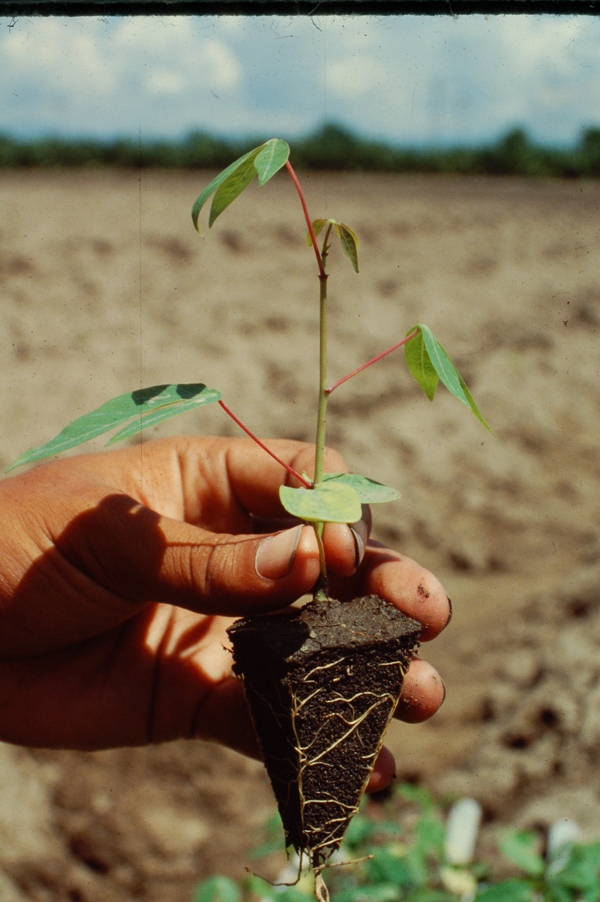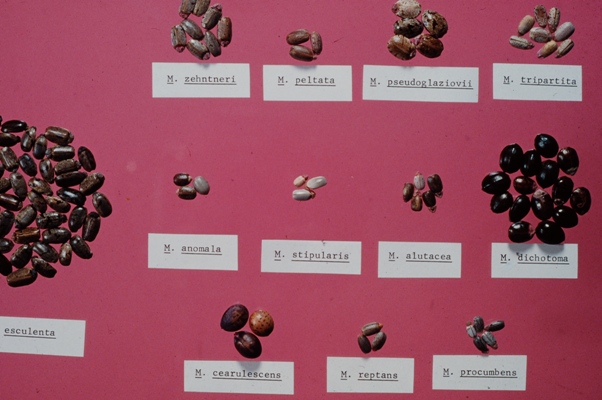Seed banks for cassava genetic resources
Contributors to this page: CIAT, Colombia (Daniel Debouck); IITA, Nigeria (Dominique Dumet); Bioversity International/ILRI, Ethiopia (Alexandra Jorge); independent consultant (Clair Hershey); INIA, Peru (Llerme Rios).
When seed banks are used
Commercial plantings of cassava are done from cuttings (vegetative propagation), but many cultivated varieties also produce botanic seeds. Seed propagation is an important feature of breeding programmes – the principal means of recombining traits from different genotypes. In addition, all wild species of cassava are seed-propagated in nature and mostly seed-propagated in genebanks.
|
|
Seed banks are used:
- To conserve genes from cultivated types of cassava that produce botanic seeds.
- To conserve genes of wild species, which are difficult to maintain in field collections outside their natural habitat or under in vitro conditions.
- To conserve the genes of improved varieties and breeding lines.
Germplasm maintained in seed form is principally useful as a source of genes for breeding work and not directly as a source of varieties for the farmers, as the seeds only preserve the genes and not the specific gene combinations that define each variety. A large part of cassava seed storage is done by the breeders in their work of crossing and genetic improvement and is not formally part of a genebank system.
Further studies should be done in the future to fully take advantage of the long-term potential benefits of seed conservation of cassava as a part of the overall package of genetic resources management.
How it should be done
Cassava
|
|
There are no standardized recommendations for the production of cassava seeds for conservation in genebanks. Because cassava landraces are all highly heterozygous, the seeds they produce will segregate widely. It is not possible to reproduce the parent type through seed. However, seeds can be used to conserve the full array of genes, if the appropriate pollination and sampling methods are used. A working group on cassava conservation strategies (Hershey, 2008) suggested that the best way to develop seed populations would be by selfing the plants within an accession. This would have the advantage that only the genes from that accession are passed on through the seed, as opposed to “mixing” or “dilution” that would be caused by crossing with other accessions (as, for example, would occur if open-pollinated seeds were collected). A disadvantage of selfing as a means of seed production is that cassava suffers inbreeding depression in most cases. The plants that result from selfing will generally be less vigorous than the parent and, in some cases, this loss of vigour can compromise the survival of plants in the field and their ability to reproduce either vegetatively or sexually.
There are as yet no standards developed for the number of seeds that should be produced for selfed accessions of cassava as a means of conservation. In general, the main constraints will be the ability of a particular clone to flower and produce seeds and the high labour and management costs of controlled seed production. There is a need for further research on methods to enhance flower and seed production in cassava, as well as the effects of selfing across a wide range of genotypes.
Cassava seeds are orthodox in their behaviour and therefore should be conserved under conventional conditions of low humidity and low temperatures (Ellis et al. 1981). IITA (1979) reported storing seeds for up to seven years without losing germination at 5oC and 60% relative humidity. There do not appear to be any genebanks that conserve seeds from accessions as a means of conserving genetic diversity of Manihot esculenta. Nonetheless, it is a viable option that needs further study. Seeds can also be preserved in liquid nitrogen for a longer preservation period (Marin et al. 1990, Mumford and Grout 1978). Seeds can be treated with an insecticide/fungicide and stored in foil packages, as with other orthodox species such as the major cereal grains. Currently, however, there do not appear to be any genebanks storing cassava accessions in this manner.
Wild species
|
|
The wild species are all propagated by seed in their native habitats and the genebanks that conserve wild species typically propagate them by seed rather than vegetatively. Species vary in their germination ability. Some species benefit from embryo rescue but others not. It is generally recommended to plant seeds in controlled conditions in containers and then transplant healthy seedlings to the field. Some seeds of each accession should be kept as a reserve in cold storage.
References and further reading
Ellis RH, Hong TD, Roberts EH. 1981. The influence of desiccation on cassava seed germination and longevity. Ann. Bot., 47:173-175.
Iglesias C, Hershey C, Calle H, Bolaños A. 1994. Propagating cassava (Manihot esculenta) by sexual seed. Expl. Agric. 30:283-290.
Lima MC, Velasquez H, Santos LG, Debouck DG. GRU Handbook of procedures - seed conservation - pre-drying. GRU, CIAT, Colombia. 10pp. Available from: http://isa.ciat.cgiar.org/urg/urgweb_folder/files/handbookprocedures/en/GRU%20HandbookProceduresPreDryingApril.pdf. Date accessed: 7 October 2010.
Marin ML, Mafla G, Roca WM, Withers LA. 1990. Cryopreservation of cassava zygotic embryos and whole seeds in liquid nitrogen. Cryo-letters 11:257-264.
Mumford PM, Grout BWW. 1978. Germination and liquid nitrogen storage of cassava seed. Ann. Bot. 42:255-257.
Nassar NMA, O’Hair SK. 1985. Variation among cassava clones in relation to seed germination. Indian J. Genetics 45(2):394-398.








Leave your comments
Post comment as a guest